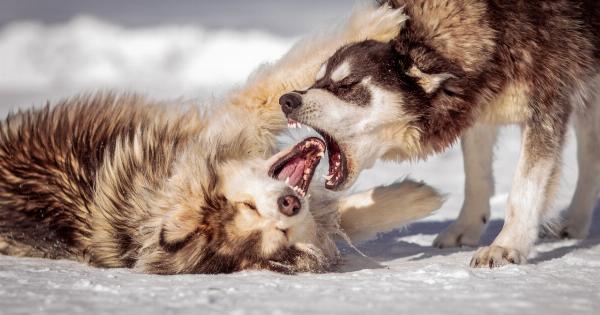When it comes to communicating with their humans, dogs have a variety of ways to convey their thoughts and feelings. One common behavior that dogs exhibit is grumbling, which can be confusing for pet owners.
While grumbling may sound like a low rumbling noise, it can actually have different meanings depending on the context and the dog’s body language.
2. Why do dogs grumble?
Dogs grumble for various reasons, and it’s important for pet owners to understand the underlying causes to address any potential issues. Here are some common reasons why dogs may grumble:.
3. Warning or Threat
One of the primary reasons dogs grumble is to warn or threaten. If a dog feels threatened or uncomfortable in a certain situation, it may emit a low growling or grumbling noise to communicate its discomfort.
This can serve as a warning to both humans and other animals to back off. It’s crucial to pay attention to the dog’s body language alongside the grumbling to determine if it’s feeling threatened or stressed.
4. Pain or Discomfort
Dogs may also grumble when they are in pain or experiencing physical discomfort. This could be due to an injury, illness, or even old age. The grumbling in this case is a way for the dog to express its discomfort and seek attention or relief.
If your dog suddenly starts grumbling with no apparent reason, it’s essential to monitor its behavior for any signs of pain or discomfort.
5. Attention-Seeking Behavior
Some dogs may grumble as a way to get attention from their owners. They may feel neglected or want to engage in playtime or receive treats.
This type of grumbling is usually accompanied by other attention-seeking behaviors such as pawing, nudging, or barking. In such cases, it’s important to provide the dog with the attention it needs and engage in positive interactions to discourage grumbling as a means of communication.
6. Fear or Anxiety
When dogs feel afraid or anxious, they may resort to grumbling. This is their way of expressing their fear or discomfort. It’s crucial to identify the triggers that cause fear or anxiety in your dog and address those underlying issues.
Creating a safe and secure environment for your dog and providing proper training can help reduce fear-related grumbling.
7. Resource Guarding
Sometimes dogs grumble to protect their valued resources, such as food, toys, or territory. This behavior is known as resource guarding. Dogs may growl or grumble when someone approaches their possessions or encroaches upon their personal space.
Proper training and socialization can help address resource guarding behavior and reduce grumbling in such situations.
8. Displeasure or Frustration
Grumbling can also indicate displeasure or frustration. If a dog is unable to fulfill its desires or if it doesn’t like a particular situation, it may express its discontent through grumbling.
It’s crucial to recognize and address the underlying cause of the dog’s frustration to prevent any further behavioral issues.
9. Communication with Other Dogs
Grumbling is a common form of communication among dogs. Dogs may use grumbling as a way to establish hierarchy or communicate boundaries with other dogs.
It’s important to observe the overall body language and context to understand if the grumbling is playful, assertive, or potentially aggressive.
10. Interaction with Humans
Lastly, dogs may grumble during interactions with humans. This can occur during play, grooming sessions, or when they are being handled in a way that makes them uncomfortable.
Understanding the specific triggers and ensuring positive and respectful interactions with your dog can help minimize grumbling in these situations.
Conclusion
In conclusion, grumbling is a multifaceted form of communication used by dogs for various reasons.
It’s crucial for pet owners to pay attention to the context, body language, and overall behavior of their dogs to accurately interpret the meaning behind the grumbling. Addressing any underlying issues and providing proper training, socialization, and affection can help create a strong bond and a harmonious relationship with your furry companion.



























